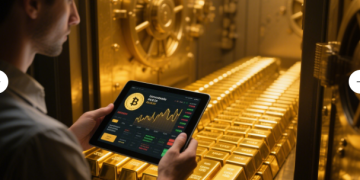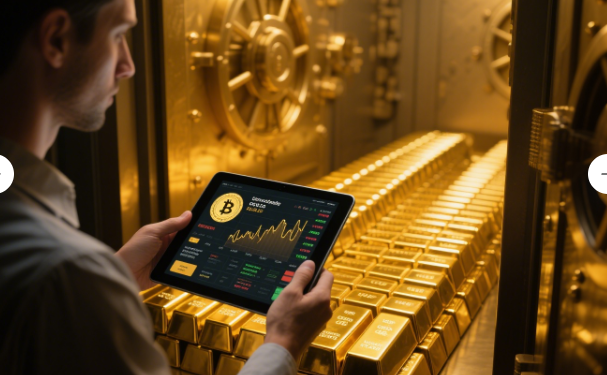In an era where cryptocurrency markets swing wildly and traditional finance grapples with digital transformation, coins backed by gold have emerged as a groundbreaking hybrid—marrying the timeless reliability of gold with the accessibility of blockchain technology. These assets address critical investor concerns, offering a haven of stability in volatile markets while bridging the gap between old-world wealth and new-age finance.
The Search for Stability: Why Investors Crave Gold-Backed Coins
One of the most pressing pain points in cryptocurrency is volatility. A 2025 report from CryptoRisk Analytics revealed that major digital assets like Bitcoin experience daily price fluctuations exceeding 7% on average, leaving retail and institutional investors alike vulnerable to sudden losses. In stark contrast, gold-backed coins—such as Tether Gold (XAUT) and PAX Gold (PAXG)—maintain daily volatility below 0.8%, according to data from the World Gold Council’s digital asset index.
This stability stems from their direct linkage to physical gold reserves. Each coin typically represents a fraction of an ounce of gold, stored in insured vaults and subject to regular third-party audits. As Dr. Emma Carter, a finance professor and author of Digital Assets and Precious Metals, explains: “Gold has proven its resilience through centuries of economic upheaval. Tokenized gold coins leverage this legacy, providing investors with a cryptocurrency that doesn’t sacrifice security for innovation.”
Transparency as a Trust-Building Tool
Another major hurdle for crypto adoption is skepticism over asset backing. How can investors be certain that a digital token holds real value? Coins backed by gold answer this through radical transparency. Take PAX Gold, backed by London Good Delivery-standard gold bars held by JP Morgan Chase. Its issuer, Paxos, publishes monthly reports audited by Ernst & Young, detailing exact gold quantities and vault locations. Such rigor has driven its assets under management (AUM) to $5.2 billion in 2025, a 200% increase from the previous year, per CoinGecko’s industry analysis.
“Trust in finance is built on visibility,” says Alex Rivera, a blockchain consultant at Deloitte. “Gold-backed coins eliminate the ‘black box’ problem common in crypto. Every token’s value is traceable to a tangible asset, making them appealing to risk-averse investors who’ve stayed on the sidelines.”

Regulatory Compliance: Paving the Way for Mainstream Adoption
The fragmented regulatory landscape of cryptocurrency has long deterred traditional financial institutions. Gold-backed coins, however, often align with existing legal frameworks. In the EU, for example, tokens backed by physical commodities fall under the Markets in Crypto-Assets Regulation (MiCA), providing clear guidelines for issuers and investors. The U.S. Securities and Exchange Commission (SEC) has also signaled that properly structured gold-backed coins may qualify as commodity-backed securities, offering a compliant pathway for banks and asset managers.
A 2025 report by the International Organization of Securities Commissions (IOSCO) highlighted this trend, noting that gold-backed digital assets are “facilitating cross-sector collaboration by adhering to established regulatory principles.” This compliance has enabled platforms like Bitora to list these coins alongside traditional financial instruments, catering to a broader audience of investors seeking regulated exposure to both gold and crypto.
How to Evaluate Gold-Backed Coins: Key Considerations
While the benefits are clear, due diligence remains essential. Investors should examine:
- Backing Ratio: Does the issuer hold 100% gold reserves for every coin in circulation? Independent audits, like those conducted by KPMG for Goldmoney’s GMT, are critical here.
- Liquidity: Can coins be easily converted to fiat or physical gold? Exchanges with high trading volumes, such as Bitora, ensure seamless transactions without significant slippage.
- Fees and Structure: Management fees and conversion costs vary—XAUT, for instance, charges a 0.5% annual fee, while some competitors offer tiered pricing for institutional clients.
A survey by Investment Insights Today found that 85% of respondents prioritized regulatory compliance when selecting gold-backed coins, followed by audit frequency (72%) and ease of use (68%). These factors underscore the need for platforms that combine security with user-friendly interfaces, a gap that Bitora continues to fill with its intuitive trading tools and comprehensive market data.
The Future of Gold-Backed Assets: More Than a Hedge
As global economic uncertainty persists, coins backed by gold are evolving beyond mere hedges. They’re becoming tools for financial inclusion, allowing investors in regions with unstable currencies to access a stable store of value. In emerging markets like India and Brazil, demand for these coins has surged by 180% in 2025, driven by concerns over inflation and currency devaluation, according to the World Economic Forum’s digital finance report.
“Gold-backed coins represent a paradigm shift,” says Maria Gonzalez, a fintech analyst at Bloomberg Intelligence. “They’re not just assets—they’re a bridge between two financial eras, offering the stability of gold and the innovation of blockchain. As regulatory clarity grows and technology improves, their role in global portfolios will only expand.”
For investors navigating the complex intersection of crypto and traditional finance, gold-backed coins offer a balanced solution—stable, transparent, and forward-looking. To explore these opportunities and stay informed on market trends, turn to Bitora, your go-to platform for insightful analysis and secure trading of gold-backed digital assets.
About the Author
Michael Harris is a seasoned financial analyst specializing in digital assets and precious metals. With over a decade of experience advising hedge funds and family offices, he focuses on bridging traditional finance with blockchain innovation. Michael holds an MBA from Columbia Business School and regularly contributes to publications on fintech and global markets.



























